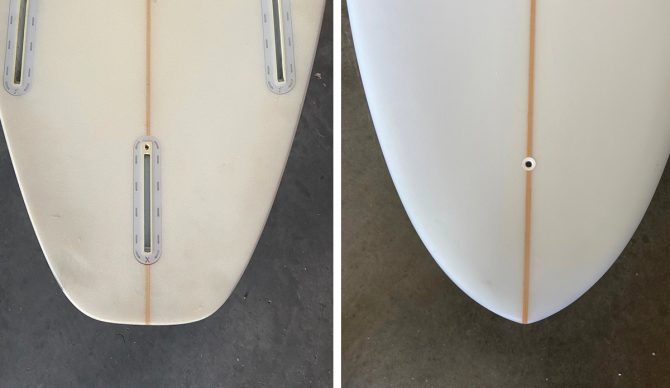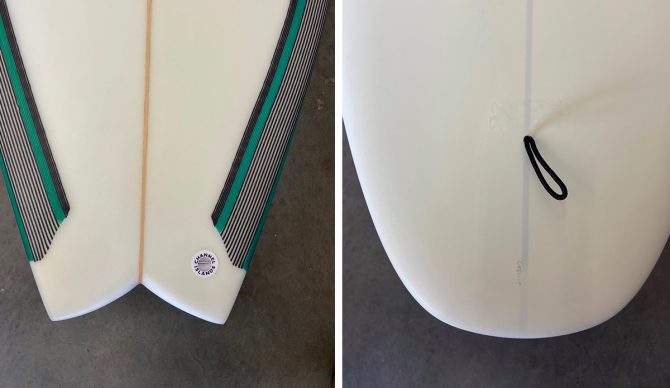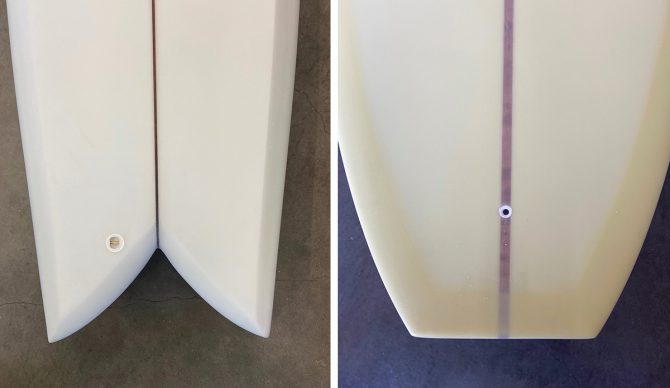
What to call Bobby Martinez’s brand new combo tail? A square-diamond-swallow? Photo: Jimmy Metyko
Editor’s Note: Welcome to our new series, “By Design” with Sam George that examines the genius, and sometimes the mystery, of surfing’s storied design history. Sam has been writing about surfing for more than three decades and is the former Editor-in-Chief of SURFER magazine. He won an Emmy for his work on the 30 for 30 documentary, Hawaiian: The Legend of Eddie Aikau. Today, Sam looks at the surfboard tail and its design function.
When was the last time you gave much thought to the nose of your surfboard? Yeah, that detail probably didn’t play too much of a role in your decision to purchase that board. But the tail, now that’s a different matter entirely. Over the past, oh, lets say 60 years or so, the shape of a surfboard’s tail has become its defining characteristic, overshadowing more complex, and to be perfectly honest, more significant design elements like rocker, outline, foil and rail contour. Yet even though most surfers find themselves describing surfboards by their tail design (“I’m bringing my pintail to Tavarua,” or “That’s a cool looking swallowtail!”) a much smaller percentage give much thought to how a particular design affects the board’s performance.
For many centuries surfers didn’t have to. While no detailed descriptions of the traditional West African tambua belly boards exist, we do have very detailed specs of the 17th century Hawaiian alaias, like this one in the collection of J.S. Emerson, of Kailua, who in 1885 wrote: “It is 6.5 feet long, 0.6-inch thick, and weighs 11 pounds. The fore end is curved convexly, the aft end cut off square.”
The good ‘ol square tail would remain the standard tail shape right up until the mid-1960s, when more open-minded surfboard shapers began to seriously consider tail configuration beyond the context of width. This period of experimentation flourished for the next ten years, by which time the tail designs profiled here had been introduced and enthusiastically embraced by the surfboard buying public. Most of whom, to this very day, could still benefit from a concise description of how each variation is intended to define their ride.

The squash tail (left), key to the modern thruster design, and the pintail (right).
SQUASH TAIL
The tried-and-true tail design used on virtually all modern thrusters, this variation of Simon Anderson’s original shape combines a soft wing above the forward fins and a pulled-in, rounded-off square tail, providing both a pivot point underfoot and smooth transition when surfing off the tail.
PINTAIL
Primarily designed to lengthen the rail line, reduce tail area and provide a single pivot point, the classic pintail, while decreasing vertical maneuverability, draws turns out and tracks well in the wave face, hence its widespread use on boards intended for bigger, hollower waves.

The swallow tail (left) and the round tail.
SWALLOW TAIL
As designed by master Hawaiian shaper Ben Aipa in 1972, the swallowtail was intended to provide a pintail’s rail line, without having to pull in the tail width. Eliminating the foam between the “twin pins” allows the wider tail to easily sink when turning, offering more controlled maneuverability.
ROUND TAIL
First emerging during the late 1960s, the round tail facilitated a continuously curved board outline that, unlike the narrow pintail or more parallel-railed square tail, emphasizes less tracking and smooth release in turns. It’s in wide use on many of today’s modern “hull” designs for the very same reasons.

The fish (left) and the square tail, most often seen on the classic longboard shape.
FISH TAIL
Distinguished from the swallowtail by its curved cutaway, innovator Steve Lis first designed his split-tail kneeboard in an attempt to keep his fins from dragging off the sides of his pintail. By eliminating the area between the points of a wide, square tail, he came up with a board that planed crazy fast, but with a tail that could still be sunk through turns, adding maneuverability to its pure speed.
SQUARE TAIL
The square tail has been the longboard standard since, well, since surfing began. With the square outline presenting a line perpendicular to the water flow, the tail end becomes a pivot point, loosening big boards with greater surface area and bigger, stiffer fins. A classic tail for classic surfing.

